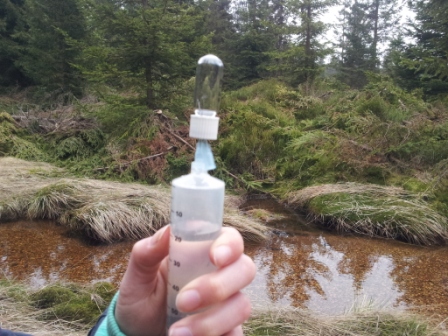TP2 Stable Isotopes
- Indicators of altered flow conditions and biological turnover in hyporheic zones
AQUAKLIF_TP2
From 04/2018 to 07/2023Principal Investigator: Johannes Barth
Staff: David Piatka, Luisa Meiritz
What is it about?

One critical factor for anticipated "good conditions" of waterbodies is the amount of dissolved oxygen. In this subproject, we investigate climate-related shifts of oxygen in streams to characterize ecological states. Based on these results, recommendations for protection of streams will help to establish a more “positive chemistry” in surface waters. A new measurement method in this subproject will apply stable isotope ratios of dissolved oxygen. It offers new opportunities to determine its pathways in the water column, in sediments and in associated ground waters. These investigations help to answer the following questions:
- Where does this vital element originate from - photosynthesis or atmosphere?
- How is oxygen consumed - by bacterial respiration or via precipitation into iron-containing minerals?
Stable isotope investigations can also apply to other elements such as carbon. Such expansions help to better understand interconnections in carbon and oxygen cycles in water compartments including pore- and ground waters. The Applied Geology group of the Friedrich-Alexander-Universität Erlangen-Nürnberg is one of the few laboratories that offers combined isotope measurements of oxygen and carbon in aqueous cycles and thus supplies new tools of investigation in aqueous research.
...and as scientists would put it:
Changes in climate and their consequences including altered temperatures, flow rates, sediment fluxes or iron-oxide depositions, can significantly modify oxygen and carbon budgets in aquatic streams. Such changes may indicate interaction-shifts between ground- and surface waters. They may also affect important biological niches, such as the hyporheic zone (i.e. the groundwater directly adjacent to streams). Further investigations of these relationships are important, because O and C are among the most reactive elements in surface- and ground waters. Their sources and sinks include inputs from landscapes as well as storage in sediments, photosynthesis, atmospheric exchange and respiration. These sources and sinks are suspected to be shifting via climatic influences and need to be better quantified to plan actions of remediation and protection of stream ecosystems.
In this subproject, new measurements of 13C/12C and 8O/16O stable isotope ratios will help to characterize aqueous phase element cycles, entry pathways and storage compartments. For example, stable isotope ratio changes can help to evaluate rates of oxygen uptake and consumption. These processes also affect aquatic carbon conversions that in turn form a basis for ecosystem functions. Investigations are ideally carried out together with modeling and analyses of biological and geochemical indicators. This advances our understanding of climate change impacts in order to plan ecosystem protection measures.





